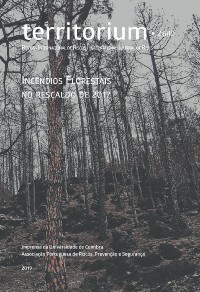Please use this identifier to cite or link to this item:
https://hdl.handle.net/10316.2/46155| Title: | Proteção civil, incêndios rurais e forças armadas: reflexões | Other Titles: | Civil protection, wildfires and armed forces: reflections | Authors: | Pereira, Francisco Grave | Keywords: | Civil protection;National Authority for Civil Protection [ANPC];armed forces;military support in emergency situations;wildfires;Proteção civil;Autoridade Nacional de Proteção Civil;Forças Armadas;apoio militar de emergência;incêndios rurais | Issue Date: | 2019 | Publisher: | Imprensa da Universidade de Coimbra | Abstract: | Os incêndios rurais de 2017 e as suas consequências vieram a relançar, mais uma vez, o debate sobre a matéria. Foram
adoptadas as conclusões dos relatórios das duas Comissões Técnicas Independentes nomeadas pela Assembleia da República
e decidido implementar um conjunto alargado de medidas. De entre essas medidas salientam-se a reestruturação da
Autoridade Nacional de Proteção Civil, a criação de uma nova entidade responsável pela gestão integrada dos incêndios
rurais e o reforço a intervenção das Forças Armadas no Apoio Militar de Emergência. No entanto, reestruturações tão
relevantes mas que vão muito além de uma única tipologia de riscos devem ser avaliadas com atenção. A proteção civil
vai muito para além dos incêndios rurais e a sua reestruturação vai muito para além de nova reestruturação da ANPC ou
do reforço do papel das Forças Armadas. Será importante pensar um modelo e implementá-lo com uma base alargada de
apoio para assegurar a sua estabilidade. Por outro lado, o apoio das Forças Armadas em situações de acidente grave ou
de catástrofe é, há muito, rotina, sendo assegurado de acordo com o conceito de duplo-uso. Ainda assim, os níveis de
ambição assumidos para esta tipologia de missões tornam necessária uma maior coordenação no planeamento, alguma
formação e aquisição de equipamentos específicos, uma regeneração oportuna de materiais e equipamentos e um novo
olhar para as potencialidades das Forças Armadas que podem ser melhor aproveitadas no domínio de uma prevenção mais
estrutural. Porque, se possível, as catástrofes evitam-se antes de se combaterem. The consequences of the 2017 forest fires yet again relaunched the debate about this subject. Taking into consideration the conclusions of the reports of two technical committees appointed by Portugal’s Parliament, it was decided to implement a wide range of measures to address the problem. Among these measures are the restructuring of the Portuguese Civil Protection Authority [ANPC] and the creation of a new body responsible for the general management of wildfires. It was also decided to strengthen military intervention in emergency military assistance operations. However, civil protection is much more than wildfires, and re-thinking it goes far beyond restructuring the Civil Protection Authority once again or strengthening the role of the armed forces. It will be important to think about a model and implement it with broad support (not only political) to avoid systematic adjustments that create instability, one of the major problems of civil protection structures. The support of the armed forces in the event of a serious accident or disaster has been routine for many years. These operations are carried out in accordance with the concept of dualuse. Even so, the levels of ambition accepted for these missions require greater coordination in planning, training and exercising, funding for specific materials and timely regeneration of equipment subjected to additional wear. The capabilities and potential of the armed forces that can be best exploited in a more structural prevention should be reappraised. If possible, it’s better to avoid disasters than to deal with them. |
URI: | https://hdl.handle.net/10316.2/46155 | ISSN: | 0872-8941 1647-7723 (digital) |
DOI: | 10.14195/1647-7723_26-2_11 | Rights: | open access |
| Appears in Collections: | Territorium |
Files in This Item:
| File | Description | Size | Format | |
|---|---|---|---|---|
| protecao_civil__incendios_rurais_e_forcas_armadas.pdf | 6.45 MB | Adobe PDF |  |
Items in DSpace are protected by copyright, with all rights reserved, unless otherwise indicated.
